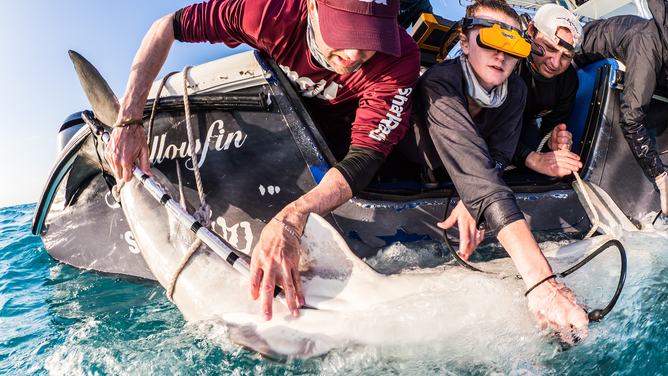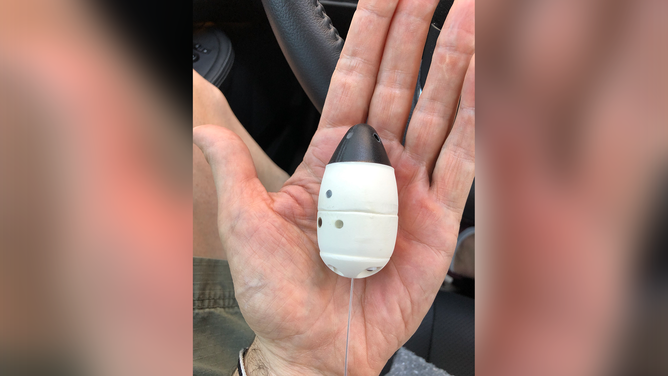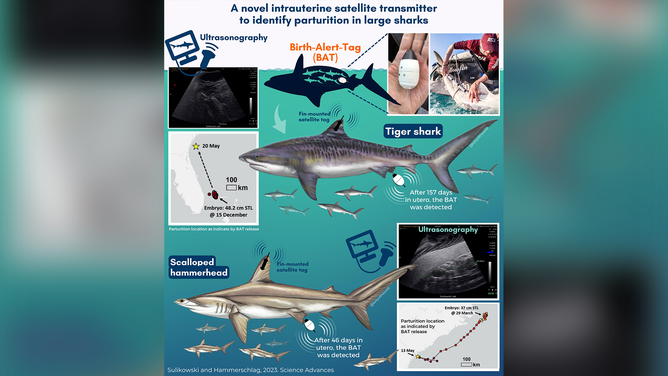New shark-saving technology aims to protect species' most vulnerable habitats
Researchers have developed a new technology that is capable of remotely documenting the location and time of the birth of shark pups, which will help scientists come up with new ways to protect the sharks’ most vulnerable habitats – where they give birth.
Watch: Diver comes face-to-face with a great white shark in South Africa
Shot from the diver’s point of view, the video shows a shark swimming through the faded blue green water – and straight toward the camera. (Courtesy: @WhiteSharkOcean via Storyful)
Shark species around the world are being threatened with extinction, and places that were once secure and safe places for them to give birth are being affected by humans and climate change.
But researchers have developed a new technology capable of remotely documenting the location and time of the birth of shark pups.
The BAT is making waves among the scientific community

Insertion of the Birth-Alert-Tag (BAT) via a specialized applicator into the cloacal opening of a pregnant tiger shark.
(Tanya Houppermans / Blue Elements Imaging)
"If (mother sharks) don't have that suitable habitat, then their babies won't be able to grow up," said James Sulikowski, senior global futures scientist at Arizona State University and director of the Sulikowski Shark and Fish Conservation Lab at ASU's New College of Interdisciplinary Arts and Sciences. "And if babies don't grow up, we have no more sharks and literally, the ocean ecosystem would collapse."
A new paper published in Science Advances explains how the new device, called the Birth-Alert-Tag (BAT), works after it was successfully implanted into a scalloped hammerhead shark and a tiger shark.
The BAT, which is shaped like an egg about 2 inches long and 1 inch wide, is inserted into a pregnant shark, where it remains alongside developing shark pups.
When the mother shark gives birth, the BAT will be expelled along with the pups and float to the water's surface. When it arrives, it sends messages announcing the time and location of the birth of the shark pups.

Image of the Birth-Alert-Tag (BAT)
(Dr. James Sulikowski)
GROUNDBREAKING RESEARCH SHOWS GREAT WHITE SHARKS MAY CHANGE COLOR TO BETTER HUNT THEIR PREY
"We've been trying to do this since we started studying sharks," Sulikowski said. "This is our holy grail. We have really advanced shark science, 20, 30, 40 years. This novel, satellite-based technology will be especially valuable for the protection of threatened and endangered shark species, where protection of pupping and nursery grounds is a conservation priority."
And the BAT device has already provided remarkable results to scientists.
For instance, it was once believed that sand sharks gave birth inland. But the new data shows they are more comfortable giving birth to pups in abandoned shipwrecks across the ocean floor.
FLORIDA COMPANY PROVIDES UNIQUE, ECO-FRIENDLY WAY TO KEEP MARINE LIFE ALIVE AFTER YOU DIE
"It was a total surprise," Sulikowski said. "For most shark species we have no idea where they give birth or how far they must travel to habitats that are essential to their survival."
The data will now be used to help scientists develop new ways to protect the sharks' most vulnerable habitats - where they give birth.

In a new study, researchers used new technologies to remotely document, for the first time in the wild, the location and timing of shark birth.
(Infographic by Bianca Rangel. Shark by Kelly Quinn / Canvas of the Wild. Photograph by Tanya Houppermans / Blue Elements Imaging )
If at first you don't succeed, try, try again
Sulikowski said it hasn't been easy, but he's enjoying the current success of the BAT device.
"We had every sort of failure happen," he said. "We had battery failures. We had firmware failures. We had antenna failures. I felt like giving up multiple times."
FLORIDA 'SHARK MATERNITY WARD' MAY HAVE BEEN FOREVER CHANGED AFTER DIRECT HIT FROM HURRICANE IAN
But Sulikowski said that thanks to his co-author, Neil Hammerschlag, they didn't give up and kept going.
"Honestly, it feels incredible to have created technology that is going to revolutionize the way we study sharks," he added.
